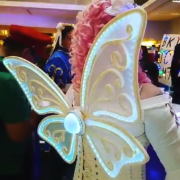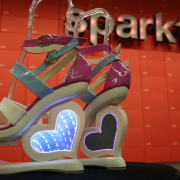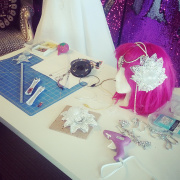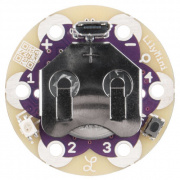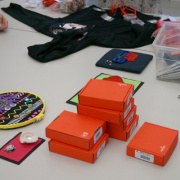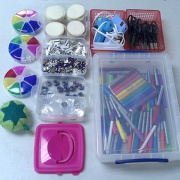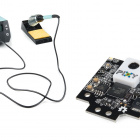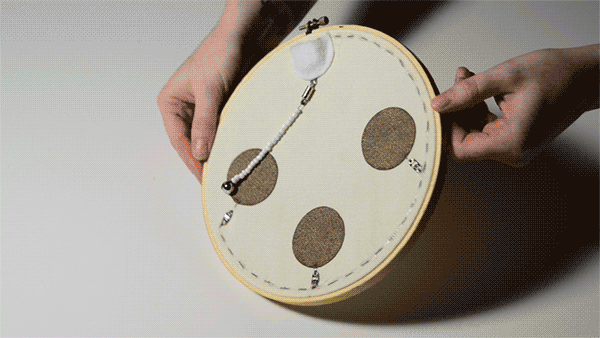Gella
Member Since: August 19, 2013
Country: United States
Angela installs some custom infinity mirrors in novelty heart-themed shoes for Valentine's fun.
If your resolutions include doing more crafts (and the winter weather is perfect for it), we've got a brand-new LilyPad product in a sparkling new kit just for you.
Here are some ideas and downloadable designs to get you inspired this Halloween season.
Angela from the Education Department visited F.I.T's Digital Spa Maker Camp to present a workshop on LilyPad and e-textiles.
LilyPad RGB LED Hookup Guide
July 18, 2019
Learn how to hook up the LilyPad RGB LED and use a common cathode RGB LED in e-textile projects.
LilyPad Vibe Board Hookup Guide
January 16, 2019
The LilyPad Vibe Board is a small vibration motor that can be sewn into projects with conductive thread and controlled by a LilyPad Arduino. The board can be used as a physical indicator on clothing and costumes for haptic feedback.
LilyPad Basics: Powering Your Project
September 24, 2018
Learn the options for powering your LilyPad projects, LiPo battery safety and care, and how to calculate and consider power constraints on your projects.
LilyPad Buttons and Switches
July 23, 2018
Learn about the button and switch offerings in the LilyPad line and how to use them.
SparkFun Paper Circuit Kits
July 5, 2018
Learn how to build a simple paper circuit using copper tape, a 5mm LED, and a 3V coin cell battery.
LilyPad USB Plus Hookup Guide
June 7, 2018
The LilyPad USB Plus is a sewable microcontroller that you can use with Arduino.
LilyPad Light Sensor V2 Hookup Guide
June 7, 2018
How to hook up the LilyPad Light Sensor as well as some project ideas and example code.
Adapting LilyPad Development Board Projects to the LilyPad ProtoSnap Plus
May 24, 2018
An overview of the updates made in the redesign of the LilyPad Development Board to the LilyPad ProtoSnap Plus and how to adapt code written for the old board to the new one.
LilyPad Tri-Color LED Hookup Guide
April 20, 2018
Learn how to hook up the LilyPad Tri-Color LED and use a common anode RGB LED in e-textile projects.
LilyPad Temperature Sensor Hookup Guide
January 23, 2018
How to hook up the LilyPad Temperature Sensor as well as some project ideas and example code.
LilyPad Development Board Activity Guide
December 7, 2017
Learn how to program in Arduino with the LilyPad Development Board. This guide includes 11 example activities that use the pre-wired LilyPad boards on the LilyPad Development Board.
LilyPad E-Sewing ProtoSnap Hookup Guide
December 7, 2017
Explore the LilyPad E-Sewing ProtoSnap and learn how to build it into a project.
LilyPad ProtoSnap Plus Activity Guide
December 7, 2017
Learn how to program in Arduino with the LilyPad ProtoSnap Plus. This guide includes 10 example activities that use the pre-wired LilyPad boards on the LilyPad ProtoSnap Plus.
Getting Started with LilyPad
October 27, 2017
An introduction to the LilyPad ecosystem - a set of sewable electronic pieces designed to help you build soft, sewable, interactive e-textile projects.
LilyPad ProtoSnap Plus Hookup Guide
October 5, 2017
The LilyPad ProtoSnap Plus is a sewable electronics prototyping board that you can use to learn circuits and programming with Arduino, then break apart to make an interactive fabric or wearable project.
LilyPad Basics: E-Sewing
December 17, 2016
Learn how to use conductive thread with LilyPad components.
Powering LilyPad LED Projects
December 17, 2016
Learn how to calculate how many LEDs your LilyPad project can power and how long it will last.
LilyMini ProtoSnap Hookup Guide
December 17, 2016
Explore the LilyPad LilyMini ProtoSnap and learn how to use it.
Illuminated Mask
December 16, 2016
Use LilyPad LEDs, a switched battery holder, and coin cell battery to make a fun light up mask for your next costume party.
Glowing Pin
December 16, 2016
Create a quick and easy piece of e-textile art using a LilyPad LED, battery holder, conductive thread, and coin cell battery.
Night-Light Pennant with LilyMini ProtoSnap
December 16, 2016
Use the pre-programmed LilyMini ProtoSnap to make an interactive pennant that reacts to ambient light levels.
Light-Up Plush
December 16, 2016
Craft a light-up plush with LilyPad LEDs controlled by pressing a button and sliding a switch in the creature's hands.
Pokémon Go Patches with EL Panels
August 3, 2016
Add a cloth stencil over EL panels to create glowing logos and designs.
Paper Circuit Pin
April 11, 2016
This quick craft project shows you how to create a circuit using copper tape instead of wire to light up an LED and make a wearable piece of e-craft art.
LilyPad Buzzer Hookup Guide
November 19, 2015
How to hook up the LilyPad Buzzer and make sound with code.
Choosing a LilyPad Arduino for Your Project
October 27, 2015
Not sure which LilyPad Arduino is right for you? We'll discuss the features of each and help you decide.
Light Up Pennant with E-Textiles
September 17, 2015
Show your school spirit, geek pride, or fandom with a light up pennant using the LilyTwinkle or LilyPad Arduino.
LilyPad Pixel Board Hookup Guide
September 16, 2015
Add changing colors to your wearable projects using LilyPad Pixel Boards.
LED Robot Pop Up Card
August 19, 2015
Craft a paper circuit pop up card with a cycling RGB LED, battery, and copper tape.
LED Butterfly Pop Up Card
August 19, 2015
Craft an illuminated butterfly pop up card with copper tape, two LEDs, and a battery.
Planning a Wearable Electronics Project
August 13, 2015
Tips and tricks for brainstorming and creating a wearables project.
The Great Big Guide to Paper Circuits
May 22, 2015
Let's take a look at different materials we can use to combine paper crafting and electronics.
Light Up Silk Flower Corsage
April 20, 2015
Combine a silk flower with a built-in RGB LED and some LilyPad Switches to create a customizable accessory.
LilyTiny Plush Monster
January 27, 2015
Craft a stuffed monster while exploring the LilyTiny preprogrammed microcontroller. This is a project based on the Plush Monster Activity created at MIT's High-Low Tech Lab by Emily Lovell, Jie Qi, and Natalie Freed.
Light-Up Valentine Cards
January 27, 2015
Light up your love with paper circuits - no soldering required!
Insulation Techniques for e-Textiles
January 22, 2015
Learn a few different ways to protect your conductive thread and LilyPad components in your next wearables project.
Let It Glow Holiday Cards
November 20, 2014
Craft a glowing card for friends and family this holiday season with paper circuits - no soldering required!
Twinkling Trick or Treat Bag
October 2, 2014
Make a light up goodie bag with conductive thread, LEDs, and the LilyTwinkle!
LilyPad Development Board Hookup Guide
July 28, 2011
The LilyPad Development Board is a sewable electronics prototyping board that you can use to learn circuits and programming with Arduino, then break apart to make an interactive fabric or wearable project.
-
We are actively working on the Windows 7 and 8 driver issues, but don't have a solution for you at the moment.
-
This version of LilyPad will not show on a port if the on board power switch is set to OFF. Try double checking that it is in the on position and see if that makes it visible.
-
AAA holders are a great option too, especially because those are a lot easier to find locally than some of the specialty batteries like LiPos. One thing to make sure to check if you have a JST terminated battery holder is that you disconnect it when you connect to a USB power source while programming boards that have charging circuits built-in (such as LilyPad).
I've heard tips about being able to find coin cells in dollar/discount stores too. They can be quite a pain to acquire with the shipping restrictions put in place in the last couple of years for manufacturers and resellers.
-
I actually had a lot of conversations about this at Denver Comic Con this weekend when people were asking how I powered my light up fairy costume. I installed batteries in strategic places on a thigh band I could reach instead of the more 'intuitive' placement inside my light up wings because it would be hard to reach them in case of emergency.
I also tend towards using power banks that include an enclosure (and typically have a larger capacity than those exposed LiPos) which can be a little safer in costume applications. Micro USB connectors are also a lot easier to unplug quickly than the JST connectors if you need to do it fast.
I'm a fire spinner in my spare time so luckily most of my wardrobe is natural fibers because of potential melting hazard. A good practice to use in all costuming that includes potential exposure to sparks.
-
A few safety tips when using LiPos:
- Always store your batteries in and enclosure free of sharp objects. When installing a battery in your project, take care to keep it away from parts of your project that could pinch, poke, or strain the battery.
- Keep away from heat and moisture - Keep your LiPo battery away from environments that will damage it. Do not immerse a LiPo battery in liquids. Remove the battery from your project if it needs to be washed. Do not use or store the battery near any source of heat. To secure a battery to your project, velcro is a temporary option or sew into a pouch or place in a plastic enclosure. Never iron or hot glue on or around a LiPo battery.
- Strain relief - One of the down sides to using these LiPo batteries is their fragile power connections. These type of batteries are manufactured for a permanent install in devices, and not being removed often as can sometimes happen with wearables. It can be easy to accidentally pull or break the power wires from the terminals on the safety circuit built into the battery. You can provide strain relief to the wires by placing them to the side and securing with electrical tape - this will help with strain on the connection to the battery when pulling on them to remove. Nate shows some tips for strain relief in his LiPo Battery Care article.
- Inspect battery before each use - short circuits or damage to LiPo batteries may not always be noticeable - check the battery for puffiness, heat, or other changes. If the battery looks damaged, remove immediately.
I'm currently writing a tutorial specifically about powering LilyPad projects, so stay tuned for that soon!
For more resources to help guide which battery to choose for your project check out our Battery Technologies Guide.
We also have a guide that helps you calculate power considerations for e-textile projects Powering LilyPad LED Projects which includes a chart of approximate run times on different types of batteries and combinations of LEDs.
For some cool behind the scenes, Nate wrote an article on How Lithium Polymer Batteries are Made.
-
There are four LEDs, one under each letter. I used Heat'n Bond iron-on double sided adhesive, though you do have to be a bit careful with acrylic felt cause it can melt if you get the iron up too hot. I think I just used hot glue to attach the logo to the hat, it's held up over a few years now. I've got a few extra hats in my studio that I was going to use for a tutorial, maybe it's time to dig those out!
Here are two resources that aren't the exact project but go over some helpful techniques Insulation Techniques for E-Textiles and Planning a Wearable Electronics Project.
-
That hat is one of my favorite builds, there isn't a full tutorial, but you can see some detail photos in the light sensor hookup guide. If you'd like I can grab some of my illustrations/artwork for planning and add them to the tutorial for reference.
-
This tutorial was created to go with our hand-sewn project kits, but I'll update the tutorial to reflect sewing machine considerations and possibly do a dedicated tutorial on those techniques. Like any thread, they technically can go in a sewing machine but can have varying degrees of success depending on your machine and tension settings. The bobbin that the thread comes on is not compatible with every machine, but can be rewound on other bobbins. I recommend using it in the bobbin to begin with.
Here are some resources on machine sewing with conductive thread: http://www.instructables.com/id/Selection-Guide-of-Conductive-Thread-for-Machine-S/ http://www.instructables.com/id/eTextiles-Sewing-Machines-and-Conductive-Thread/
-
One option for protecting the battery is covering with felt. Feldi left the battery holder exposed for demonstration, but in use it is best to protect any exposed components from shorts as you pointed out. You can see a demonstration of this in my tilt sensor project. The conductive thread is also insulated with flexible fabric glue for added protection.
-
When I was prototyping the small heart mirrors I thought they would be fun a little larger and with thinner mirrors to make a statement necklace. I'll write up a tutorial and release the files for others to DIY if I end up building them.





E-Textiles Workshop: Beginner (50 Student)
- Materials for workshop with (1) battery holder, (1) coin...





Color Changing Circuit with LilyPad Pixels
Experiment with color mixing using a LilyPad Arduino Simple...



Night-Light Pennant with LilyMini ProtoSnap
All the electronics you will need to make a night-light...

